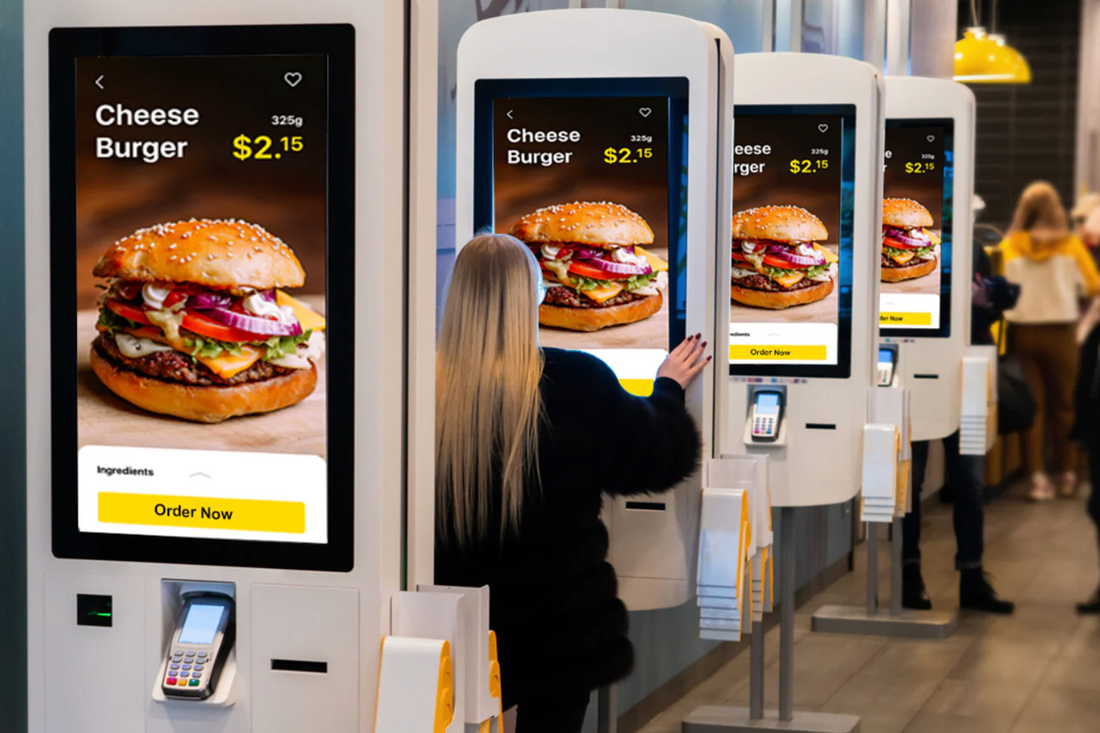The Quick Service Restaurant (QSR) industry is well-known for its commitment to speedy and efficient service. One technology that's been pivotal in achieving this is the self-service kiosk. These digital stations allow customers to place orders, customise meals, and make payments with a few taps on a touchscreen. Let's explore how self-service kiosks are transforming the QSR landscape.
Optimising Operations and Reducing Wait Times
In the fast-paced world of QSRs, speed is of the essence. Self-service kiosks significantly reduce customer wait times by automating the order-taking process. Customers can swiftly navigate the menu, make their selections, and pay, without having to queue at a traditional counter. Not only does this enhance customer satisfaction, but it also allows staff to focus on order preparation, further streamlining operations.
Enhancing Customer Experience
Self-service kiosks have also reshaped the QSR customer experience. With user-friendly interfaces and vivid digital menus, kiosks make the ordering process more interactive and enjoyable. Customers have full control over their orders, allowing them to customise their meals exactly to their liking. This ability to personalise has become a key differentiator for QSRs, giving them an edge in the fiercely competitive market.
Boosting Sales with Upselling and Cross-Selling
Self-service kiosks present an exciting opportunity for QSRs to increase sales. By using smart recommendation algorithms, these kiosks can suggest add-ons or upgrades that complement a customer's order, prompting upselling and cross-selling. For instance, a customer ordering a burger might be prompted to make it a meal with a side and drink, or upgrade to a larger size. This strategy not only drives revenue but also enhances the customer's dining experience by suggesting items they might enjoy.
Looking ahead, the potential of self-service kiosks in the QSR industry is vast. With advancements in technology, these kiosks could offer even greater levels of personalisation and convenience. For example, kiosks could recognise returning customers and suggest orders based on their past preferences, further speeding up the ordering process. Alternatively, they could integrate with mobile ordering apps, allowing customers to place orders on their smartphones and simply use the kiosk for swift payment and order collection.
However, as with any technology, the implementation of self-service kiosks must be thoughtfully managed. QSRs must ensure their kiosks are user-friendly and accessible to all, including those with disabilities. They must also consider hygiene factors, especially in a post-COVID world, by ensuring screens are regularly cleaned or by exploring touchless interaction technologies. Additionally, the transition to self-service should not compromise the quality of customer service. Staff should be available and ready to assist customers who may be hesitant or unfamiliar with using the kiosks.
Maximising Space and Reducing Costs
The integration of self-service kiosks in the QSR industry also opens up new possibilities for restaurant layout and design. With smaller physical footprints than traditional counters, kiosks can help maximise space, allowing for more seating or kitchen space. Furthermore, kiosks can help reduce labour costs in the long run, as fewer staff are required for front-of-house operations.
Leveraging Data for Business Insights
Self-service kiosks can gather a wealth of data about customer preferences and ordering habits. This data can offer valuable insights for QSR businesses, enabling them to make data-driven decisions about menu changes, promotional offers, or operational improvements. For instance, if data shows that a particular menu item is frequently paired with another, a QSR might consider offering a new combo deal.
Integrating Loyalty Programs
Another exciting application of self-service kiosks is the integration of loyalty programs. Customers can easily sign up for rewards programs, collect points, and redeem rewards through the kiosk interface. This strategy can enhance customer loyalty and encourage repeat visits, which is crucial for success in the QSR industry.
Future Considerations
Looking ahead, self-service kiosks are likely to become even more prevalent in the QSR industry, driven by evolving customer expectations and technological advancements. One potential future development is the integration of AI and machine learning, enabling even smarter recommendations and personalised customer experiences.
Furthermore, we might also see the rise of multi-lingual kiosks, making fast food more accessible to a diverse customer base. Voice recognition technology could also be integrated, offering a hands-free option that enhances accessibility and hygiene.
However, the rise of self-service kiosks also brings new challenges and considerations. For instance, QSRs must ensure that the introduction of kiosks doesn't alienate customers who prefer a more traditional service model. Offering a mix of service options, including both kiosks and staffed counters, could be a viable solution.
Data security is another crucial concern. As kiosks handle sensitive customer information, robust security measures must be in place to protect data privacy. Businesses must be transparent about how they collect and use data, and comply with all relevant data protection regulations.
In conclusion, self-service kiosks are reshaping the QSR landscape, offering benefits such as improved operational efficiency, enhanced customer experience, and increased sales. As technology continues to advance, the possibilities for these digital stations are virtually limitless. However, successful implementation requires careful consideration of factors such as user-friendliness, data security, and the preservation of quality customer service. As we look to the future, it's clear that self-service kiosks will continue to play a pivotal role in the evolution of the fast food industry.
For further support and expert advice on how to revolutionise your Quick Service Restaurant, get in contact with us at James Hogg Display.

